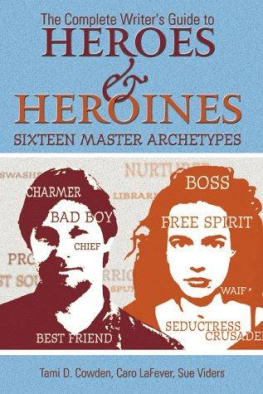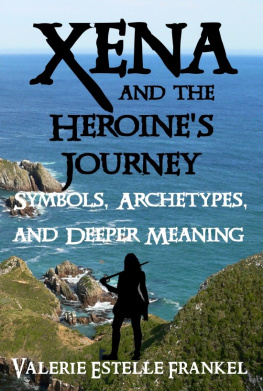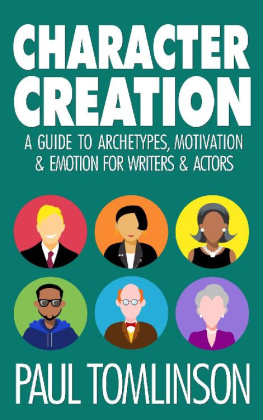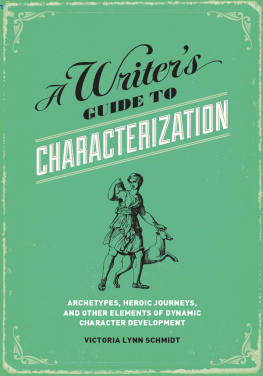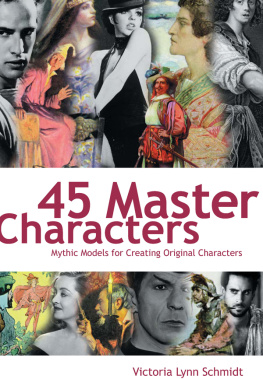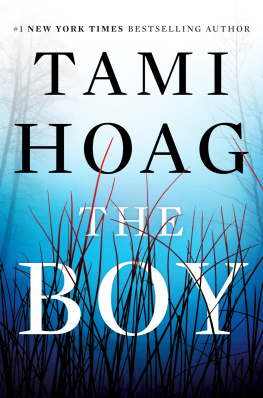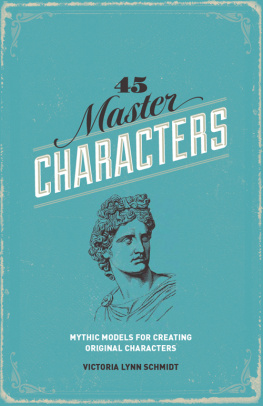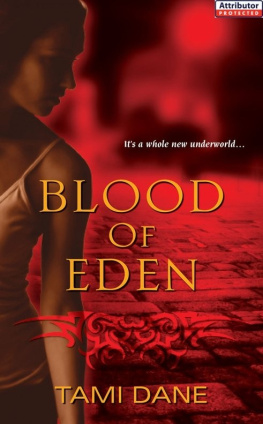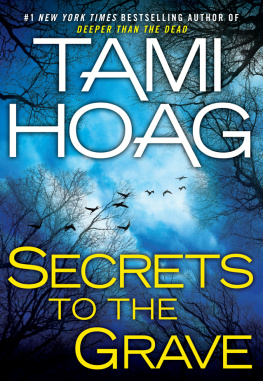Tami D. Cowden - Complete Writers Guide to Heroes and Heroines: Sixteen Master Archetypes
Here you can read online Tami D. Cowden - Complete Writers Guide to Heroes and Heroines: Sixteen Master Archetypes full text of the book (entire story) in english for free. Download pdf and epub, get meaning, cover and reviews about this ebook. year: 2000, publisher: Crown Publishing Group, genre: Non-fiction. Description of the work, (preface) as well as reviews are available. Best literature library LitArk.com created for fans of good reading and offers a wide selection of genres:
Romance novel
Science fiction
Adventure
Detective
Science
History
Home and family
Prose
Art
Politics
Computer
Non-fiction
Religion
Business
Children
Humor
Choose a favorite category and find really read worthwhile books. Enjoy immersion in the world of imagination, feel the emotions of the characters or learn something new for yourself, make an fascinating discovery.
- Book:Complete Writers Guide to Heroes and Heroines: Sixteen Master Archetypes
- Author:
- Publisher:Crown Publishing Group
- Genre:
- Year:2000
- Rating:5 / 5
- Favourites:Add to favourites
- Your mark:
- 100
- 1
- 2
- 3
- 4
- 5
Complete Writers Guide to Heroes and Heroines: Sixteen Master Archetypes: summary, description and annotation
We offer to read an annotation, description, summary or preface (depends on what the author of the book "Complete Writers Guide to Heroes and Heroines: Sixteen Master Archetypes" wrote himself). If you haven't found the necessary information about the book — write in the comments, we will try to find it.
Complete Writers Guide to Heroes and Heroines: Sixteen Master Archetypes — read online for free the complete book (whole text) full work
Below is the text of the book, divided by pages. System saving the place of the last page read, allows you to conveniently read the book "Complete Writers Guide to Heroes and Heroines: Sixteen Master Archetypes" online for free, without having to search again every time where you left off. Put a bookmark, and you can go to the page where you finished reading at any time.
Font size:
Interval:
Bookmark:




NOTES FROM THE EDITOR
Why is a book about Hero and Heroine Archetypes important to screenwriters? Because creating believable characterizations that connect with the audience is probably one of the most difficult aspects of writing an author faces. The weakest component of many screenplays and novelsnot to mention numerous produced films and television showsis characterization, especially in the inner life of individual. Why is this so? The creation of rich characterizations defies easy codification, making it very hard to understand, let alone teach. Sometimes an author creates a great character, other times characters just fall flat. When a book comes along that provides new insight into understanding characters and how they function, all writers should take notice.
In The Complete Writer's Guide to Heroes & Heroines, authors Tami D. Cowden, Caro LaFever and Sue Viders offer not a reductive theory on how to create complex characters, but a broad analysis of the basic male and female archetypes populating the vast field of literature and film. Through the use of numerous examples from films and books, they show how the archetypes operate beneath the faces of the most original characters to forge a link with the audience based in shared human experiences.
Writers and screenwriters alike will find this book an invaluable tool to understanding their characters at deeper levels. All good writers have to be psychologists who must understand their characters' actions and motivations. Through the description of the sixteen archetypes, authors Cowden, LaFever and Viders provide ample material to help writers know their creations. They present a cohesive method for organizing biographical information to aid the writer in clearly seeing a character in conflict, which is essential to the plot of every story. They show how the identification of the archetype at work in a character sheds light on the meaning of his inner conflict and the direction of his solution. They illustrate the advantage of combining archetypes to create more complex characters. In their discussion of the antagonism inherent in archetypal relationships between the opposite sexes, pairs and ensembles, they offer patterns of growth and reconciliation. All of these serve to broaden and deepen characters' dimension, which can only make for more authentic, more believable characters.
Linda J. Cowgill is a produced screenwriter who has also written for prime-time television. She has taught screenwriting seminars for the American Film Institute at the Kennedy Center in Washington, D.C., and at the Boston Film Institute. Currently, she teaches screenwriting at Loyola Marymount University. Ms. Cowgill is the author of the popular film school textbooks Writing Short Films and Secrets of Screenplay Structure.
INTRODUCTION
Stories have been told since the dawn of language. The focus of these tales has always been the people who inhabited them; events were recounted only as a backdrop to the exploits of the heroes and heroines. From the earliest days, storytellers have known a simple truth: strong characters may carry a weak plot, but weak characters cannot be hidden by a strong plot.
Since those primitive times to the present day, writers have woven tales about heroes and heroines, spun webs and built mazes through which protagonists must find their way to truth and happiness, and to their destiny. Sometimes these fictional men and women have been larger than life, but they also have been regular people who became heroic when faced with adversity. But high or low, brilliant or average, characters whose stories survive through the ages are those heroes and heroines that ring true to the human spirit. Their personalities, tragedies and triumphs, their decisions made in the heat of battlestrike a chord of recognition in all who hear the tale.
Why does this happen? Why do some characters reach into the collective heart and pluck the heartstrings of every reader, while others are immediately discarded into the dustbin of memory?
Great heroes and heroines have emerged from literature through the ages. These universal characters are instantly recognized by the audience. Their motives are clear, their personalities unclouded. Times, settings, actions and events may vary, but these protagonists shine like diamonds among rubble, the audience immediately connecting and empathizing with their journey.
Carl Jung theorized that humans have a collective unconscious, "deposits of the constantly repeated experiences of humanity ... a kind, of readiness to reproduce over and over again the same or similar mythical ideas ..." This shared memory of experiences has resulted in a resonance of the concepts of hero and heroine that transcends time, place and culture. Jung called these recurring personalities ARCHETYPES, from the Greek word archetypos, meaning "first of its kind."
A true hero or heroine is one who taps into these universal emotions and feelings. A writer who learns how to use archetypes can more easily create a hero or heroine who jumps off the pages and grabs the heart and head of the reader. These characters live in the minds of the audience long after the last page is turned or the last film clip is viewed.
Characters who fall within these archetypes have starred in story after story, entertaining and informing the human experience for millennia. A review of myths, legends, fairy tales, epic poems, novels and film reveals that the protagonists who recur in these stories fall into sixteen distinctive categories, eight each for the heroes and heroines. These are the sixteen heroic archetypes.
In the pages that follow, we explain these sixteen archetypes, show ways to use archetypal characters in fiction writing and explore how the archetypes interact with each other.
Section I sets forth the eight HEROES and Section II the eight HEROINES.
Each archetype is discussed in detail. First, we provide a short sketch of the archetype's demeanor and attitudes. Patterns of viewing and responding to the world emerge. Discussion of the common dominant qualities, both positive and negative, found in each archetype comes next. Often, there is a relationship between these flaws and virtues. An archetype's strength frequently proves a weakness as well.
Next, the archetype's likely family background and childhood are reviewed. Of course, nothing is set in stone, but a character's motivation is generally traceable to an experience or series of experiences. Upbringing, family life and relationships with childhood peers are often pivotal in the development of the archetypal structure of the character. Again, we are not saying that each example of a character within an archetype has exact ly the same background. We merely suggest that certain similarities in back story are likely.
Next we examine the two s tyles of each archetype. A style is the pattern of behavior in which the archetype is made manifest. Each style shows the basic characteristics of the archetype, but presents those patterns in slightly different ways. Mr. Spock of Star Trek and Lieutenant Columbo of Columbo are both members of the same archetype, but Spock's precise and direct manner is very different from Columbo's roundabout method.
Font size:
Interval:
Bookmark:
Similar books «Complete Writers Guide to Heroes and Heroines: Sixteen Master Archetypes»
Look at similar books to Complete Writers Guide to Heroes and Heroines: Sixteen Master Archetypes. We have selected literature similar in name and meaning in the hope of providing readers with more options to find new, interesting, not yet read works.
Discussion, reviews of the book Complete Writers Guide to Heroes and Heroines: Sixteen Master Archetypes and just readers' own opinions. Leave your comments, write what you think about the work, its meaning or the main characters. Specify what exactly you liked and what you didn't like, and why you think so.

